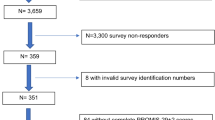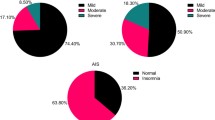Abstract
Background
Whether having a stable and predictable lifestyle is associated with health care use and health status among HIV patients is unknown.
Objective
To develop and test the reliability and validity of a measure of life chaos for adults with HIV and examine its association with health care use and health status.
Design
Prospective cohort study.
Participants
Two hundred twenty HIV-infected persons recruited from those who tested positive in a mobile testing van and from HIV clinics serving low-income populations.
Measurements
Participants completed a survey every 6 months, assessing their health care use, SF-12 mental and physical health status and life chaos.
Results
Cronbach’s alpha for the six-item measure of chaos was .67. Those without a spouse or partner and those with one or more unmet social service needs, such as housing or transportation, had higher chaos scores. Compared to those with less chaos, those with more chaos were less likely to have two or more outpatient visits (adjusted odds ratio [OR] 0.48, 95% confidence interval [CI]: 0.24–0.98), more likely to have two or more missed visits (adjusted OR 2.30, 95%CI: 1.20–4.41) in the 6 months before study enrollment and had lower mental health status at enrollment and at follow-up. Life chaos was not associated with emergency department visits or physical health status.
Conclusions
We created a new measure of life chaos, which was associated with outpatient visits and mental health status. Chaos may be an important barrier to regular medical care. Future studies need to test this measure in more diverse populations and those with other diseases.
Similar content being viewed by others
References
Penniman TV, Taylor SL, Bird CE, Beckman R, Collins RL, Cunningham W. The associations of gender, sexual identity and competing needs with healthcare utilization among people with HIV/AIDS. J Natl Med Assoc. 2007;99(4):419–27.
Cunningham WE, Andersen RM, Katz MH, et al. The impact of competing subsistence needs and barriers on access to medical care for persons with human immunodeficiency virus receiving care in the United States. Med Care. 1999;37(12):1270–81.
Golin CE, Liu H, Hays RD, et al. A prospective study of predictors of adherence to combination antiretroviral medication. J Gen Intern Med. 2002;17(10):756–65.
Murphy DA, Roberts KJ, Martin DJ, Marelich W, Hoffman D. Barriers to antiretroviral adherence among HIV-infected adults. AIDS Patient Care STDS. 2000;14(1):47–58.
Ware NC, Wyatt MA, Tugenberg T. Adherence, stereotyping and unequal HIV treatment for active users of illegal drugs. Soc Sci Med. 2005;61(3):565–76.
Matheny J, Adam P, Wachs TD, Ludwig JL, Phillips K. Bringing order out of chaos: Psychometric characteristics of the confusion, hubbub, and order scale. J Appl Dev Psychol. 1995;16(3):429–44.
Ware J, Jr., Kosinski M, Keller SD. A 12-Item Short-Form Health Survey: construction of scales and preliminary tests of reliability and validity. Med Care. 1996;34(3):220–33.
Hays RD, Wang E. Multitrait Scaling Program: MULTI. Proceedings of the Seventeenth Annual SAS Users Group International Conference. 1992:1151–6.
Panel on Clinical Practices for Treatment of HIV Infection. Guidelines for the use of antiretroviral agents in HIV-1-infected adults and adolescents: Department of Health and Human Services;2003 July 14.
Morales LS, Cunningham WE, Galvan FH, Andersen RM, Nakazono TT, Shapiro MF. Sociodemographic differences in access to care among Hispanic patients who are HIV infected in the United States. Am J Public Health. 2004;94(7):1119–21.
Petrill SA, Pike A, Price T, Plomin R. Chaos in the home and socioeconomic status are associated with cognitive development in early childhood: Environmental mediators identified in a genetic design. Intelligence. 2004;32:445–60.
Coldwell J, Pike A, Dunn J. Household chaos-links with parenting and child behaviour. J Child Psychol Psychiatry. 2006;47(11):1116–22.
Guite HF, Clark C, Ackrill G. The impact of the physical and urban environment on mental well-being. Public Health. 2006;120(12):1117–26.
Leon Bluhm G, Berglind N, Nordling E, Rosenlund M. Road traffic noise and hypertension. Occup Environ Med. 2007;64(2):122–6.
Acknowledgments
We attest that all authors meet the criteria for authorship and take responsibility for the scientific content of the manuscript.
Grant support: This project was supported by a grant from the Health Resources and Services Administration (H97HA00203). Dr. Wong received support from a Mentored Career Development Award from the National Institute on Aging (K08AG/HS21616-05) and a Faculty Development Award in Clinical Epidemiology from the Pfizer Foundation. Dr. Cunningham received support from a RCMAR grant from the National Institute on Aging (P30 AG021684) an EXPORT grant the National Center on Minority Health and Health Disparities (P20 MD000148) and a grant from the National Institute of Mental Health (R01 MH069087). Dr. Sarkisian was supported by a Paul B. Beeson Career Development Award in Aging from the National Institute on Aging (1K23AG024811).
Conflict of Interest
We have no conflicts of interest with respect to this study.
Author information
Authors and Affiliations
Corresponding author
Rights and permissions
About this article
Cite this article
Wong, M.D., Sarkisian, C.A., Davis, C. et al. The Association Between Life Chaos, Health Care Use, and Health Status Among HIV-Infected Persons. J GEN INTERN MED 22, 1286–1291 (2007). https://doi.org/10.1007/s11606-007-0265-6
Received:
Revised:
Accepted:
Published:
Issue Date:
DOI: https://doi.org/10.1007/s11606-007-0265-6




